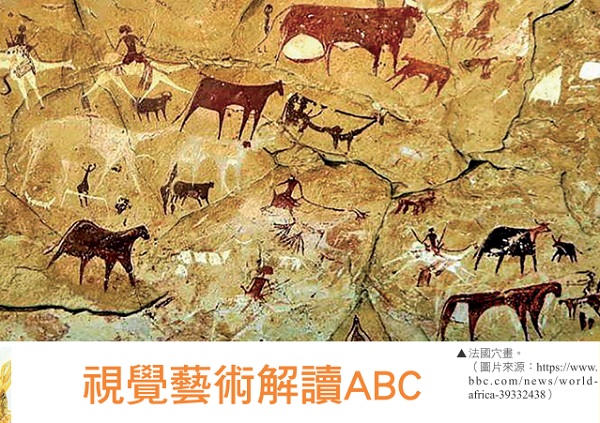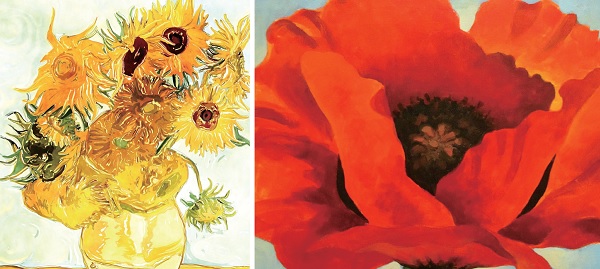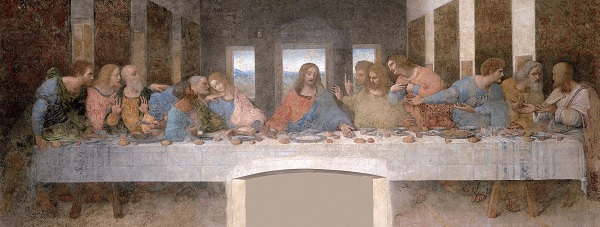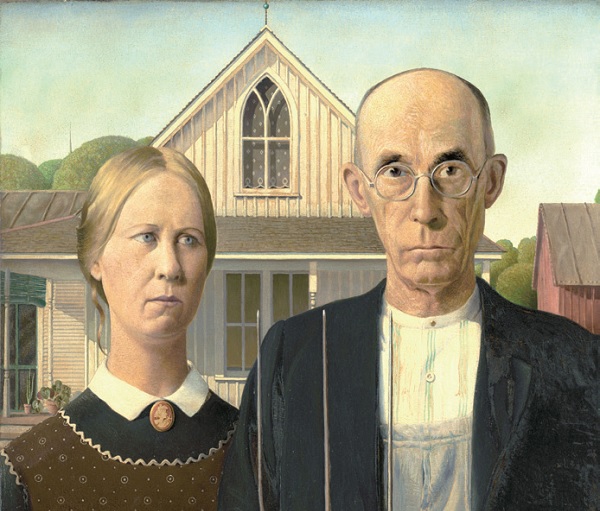Visual Arts Interpretation ABC
【Image Interpretation】Series 2

▲French cave painting. (Image Source:https://www.bbc.com/news/world-africa-39332438)

▲The artist presents the world he experiences from a fresh perspective. The picture shows Van Gogh’s Sunflowers and O’Keeffe’s Red Poppies.
(Image Source:https://images.app.goo.gl/4pW9JCGBBnu9s6297)
The so-called "visual art" covers painting, sculpture, photography; large-scale art installations and collages; public space art, street mural art; movies, TV, etc. There are many types and there is a lot to see. When reading or interpreting the many types of visual arts, you can start by grasping some common basic concepts.
The artist's representation of the world
There is a term in visual culture - "reproduction", which means to use images to re-understand, describe and define the world.
Reproduction is not just a portrait or simulation, which honestly reflects the original appearance of things; rather, the process of reproduction also contains the interpretation of the creator. Just like memory writing, although it describes the past, there must be elements of reinterpretation and construction of meaning.
For example, from French cave paintings, Middle Eastern slates, ancient Egyptian tombs to Chinese traditional paintings, they are all artists’ perceptions and expressions of the world. In the expression, the creator will want to re-express the world and re-create the world; use various innovative and creative techniques to reproduce the world.
Therefore, whether it is Van Gogh's sunflowers, Monet's lotuses in the pond, Georgia O'Keeffe's flowers, or Jackson Pollock's splatter paintings, they are all trying to make We experience parts of the world from new perspectives that we have never imagined or seen before.
Therefore, the biggest difference between viewing and reading text is that the viewer should not rush into decoding and analysis, but should first ask: What do you feel after watching? Is it to awaken your admiration for beauty? Or does it challenge your familiar sense of beauty and make you think: What the hell is this?
We can then pay attention to the different combinations of elements present in the painting. Just like Leonardo da Vinci's "The Last Supper", the entire painting does not present a frozen moment, but a moment when the disciples are having a conversation and interacting. From the painting, it can be seen that every disciple seems to be asking: "Am I the one who wants to betray Jesus?"
Look at the layout of the entire painting. Is there contrast and balance? The placement of the disciples on the left and the disciples on the right, in conjunction with the pillars on the two walls behind, are all in order. How Jesus is placed in the middle of the table, the center of the picture. He does not have the halo around his head that other portraits of Jesus have, but the light from the windows at the back achieves the same effect, emphasizing that the human part of Jesus is a luminous person. This gives Jesus and his disciples a different visual sense.
Then pay attention to the clothes of Jesus. The red robe and the blue robe give Jesus a majestic sense of glory and power. His eyes were downcast, forming a contrast with the surprise and uneasiness of the disciples. His left hand reaches out to the bread and wine, as if to establish the ritual of the Eucharist; the other hand seems to be blessing. This is Leonardo da Vinci's interpretation of Christ - a healer and a blessing.
There are a lot of details in the painting to chew on. For example, who is the betrayer? Is there any special significance to turning your back to the viewer? Does the sword in Peter's hand symbolize the sword he would later use in the Garden of Gethsemane? The finger that Thomas extended upward was probably the same finger that later poked the wound of the Lord Jesus. This is a scene in which Da Vinci "reproduces" the story of the Lord Jesus.

▲Looking closely at "The Last Supper", what feeling does this painting bring out? Taking advantage of the different elements, how did Leonardo da Vinci "reproduce" a scene from the story of Jesus?
Grasp contextual information
One thing that needs to be understood is that every piece of visual art is not only the artist's personal creation, but also a cultural product of the era in which he lived.
For example, during the Middle Ages and Renaissance, when Catholicism dominated European culture, the themes of paintings were dominated by biblical stories and beliefs. During the Romanticism period, large, dark, brooding, and noisy paintings appeared, tending to imitate "romantic" characteristics. The same features found their way into contemporary architecture and literature. Just like the cave paintings depict hunting, fishing, heating and sacrifice at that time, they fully reflect the cultural background of the time.
In art, there is also a term called "mimesis", as if landscape painting is a reproduction of nature. Of course, some people say that painters such as Cubism or Surrealism - Picasso's paintings are incomprehensible, as if they have escaped from the world of imitation. But the early 20th century, seen through the eyes of the creator, may have been chaos, disorder, violence, alienation and fragmentation. The painting may well reflect that broken world.
Therefore, when interpreting visual art, we need to have a little knowledge about the painters, including the genres of their paintings: realism, romantic, classical style, impressionism, fauvism, cubism, etc. There are also different regions: Europe, the East, Africa, etc. If you can have a little exposure to the characteristics of paintings from different regions and genres, it is like understanding the local customs and customs before traveling to a place. And if you can master some painting skills or media creation skills of different genres, you can dig out the most treasures and have the ability to talk.
Reinvention and technology change the way we see
In terms of visual art criticism, "Ways of Seeing" written by cultural and art critic John Berg is a classic work that mentions many groundbreaking reflections on images.
It is mentioned that the seductive poses and roles played by women in modern advertisements are recreations of Renaissance or Enlightenment era paintings, and are also the "ideal" women desired by male artists. 1 Hence the majority of the paintings are of nudes, posed in many unnatural and uncomfortable poses, and often looking directly at the viewer (who at the time was thought to be male).
There are great similarities between these female models and mythological figures, and they all represent female stereotypes: the peaceful mother (Virgin Mary), the secretary with no inhibitions (the diva, the king's mistress), the perfect hostess ("Watch" "the wife of the owner"), sexy beauties (Venus, frightened half-naked nymphs), etc. It seems that the advertisement relies entirely on the visual language of oil painting, which is also a reflection of the art tradition of oil painting.
Another observation concerns what happens when an artwork is reproduced over and over again. For example, print the Mona Lisa on a T-shirt; put Van Gogh's painting on a coffee cup; make a giant enlarged doll of Edvard Munch's "The Scream"; be able to make it available to everyone in the United States. A poster of Gustav Klimt's "The Kiss" hangs in a residential hall. How will these usage methods that enter daily life and be popularized change the meaning of art?
There is also the famous painting "American Gothic" (Grant Wood, 1930). Many people may not have seen the original painting, but it is everywhere on the Internet. How does this overexposure effect affect our experience of appreciating the original work at the Art Institute of Chicago?
Will the uniqueness and uniqueness of the original classic paintings be destroyed by excessive reproduction? Because the original painting also has a sense of the times that it came from a specific time and space, from a certain place. Now being mass-produced, it will somewhat change the public's response to paintings, and also reduce high-end art to mass art. Many people are exposed to these classic works of art from postcards or cards.
Berg believed that mass reproduction of visual artworks would diminish the power of the original work. Especially in the digital age, mass copying can also change and transform the image of art. Literary and cultural theory scholar Michel de Certeau calls this textual poaching (or translated text intrusion) and cultural appropriation. 2

▲The painting "American Gothic" is everywhere on the Internet. How will the overexposure affect the experience of appreciating the original work?
He described it as a bit like a poacher renting an apartment, occupying a certain text, and then filling it with his own furniture and furnishings. Many viewers of popular culture can occupy that text themselves, create new cultural products in response, and make the text their own.
For example, many fans will re-edit and create new works based on specific albums or video works. Online viewers/consumers are also increasingly accessing images from advertising, pop culture and news media - coupled with new texts, changing their meanings.
Others reinterpret the character relationships in the original TV series or online novels from a new erotic perspective. These are concrete symbols of "poaching", creating new plots based on the original text and giving them new meanings.
Some students once told me that mainland China likes to rewrite Japanese comics or animations, and can also rewrite live-action film and television dramas, which is called "fan fiction." Some students who are online novel authors have also mentioned to me that they often rewrite online novels and put themselves into characters to develop different plots, which is text poaching.
During the epidemic, when everyone stayed at home and had nothing to do, cosplaying of famous paintings became very popular. Amateurs used posed photography to recreate images of famous paintings out of fun. Then spread it widely through social networking sites and share it with friends. Importantly, the re-creations use personal images to replace the characters in the famous paintings.
However, many textual poachings of classic works will become parody. Take "American Gothic" as an example. There are all kinds of weird and bizarre copies. After seeing these, do you still want to see the original version? So the question to ponder is: does art care about being authentic? Is the value of art more or less due to authenticity?
It is somewhat certain that the popularization of an image will definitely affect how we think and see the work - whether it is for the better or for the worse.
The following are some tips for getting started with visual art appreciation:
1) What theme does the creator want to express?
2) What techniques does he use to convey the theme?
3) What are the characteristics of the characters in the image? What race, gender, social class? Like you? Why?
4) What era and geographical background is this painting from?
5) Where is the main conflict in the image? What issues are involved?
6) Do you like this work? Why?
Note:
1. John Berger, Ways of Seeing (Taipei, Wheatfield, 2005), pp. 164-165.
2. Marita Sturken and Lisa Cartwright, Practices of Looking (Taipei, Facebook Press, 2013), 94 pages.
 Could it be, senior writer. He is currently the director of the "Genesis Literary Training Bookstore", specializing in promoting the literary and cultural vision for the Kingdom of God, cultivating and shepherding literary workers. His book "Throwing a Figure in Eternity" won the 2012 Tangqing Literary Award. Other essays have won Taiwan's "United Press Literary Prose Award" and "Liang Shiqiu Literary Award". The novel has won the "Bing Xin Literature Award" in mainland China and the "Religious Literature Award" in Taiwan. He is the author of the text ministry series "Your Story, Your Heritage", "The Influence of Heaven, God's Time", etc. My lifelong dream is to see the realization of "all people reading" and "all people writing" among Christians.
Could it be, senior writer. He is currently the director of the "Genesis Literary Training Bookstore", specializing in promoting the literary and cultural vision for the Kingdom of God, cultivating and shepherding literary workers. His book "Throwing a Figure in Eternity" won the 2012 Tangqing Literary Award. Other essays have won Taiwan's "United Press Literary Prose Award" and "Liang Shiqiu Literary Award". The novel has won the "Bing Xin Literature Award" in mainland China and the "Religious Literature Award" in Taiwan. He is the author of the text ministry series "Your Story, Your Heritage", "The Influence of Heaven, God's Time", etc. My lifelong dream is to see the realization of "all people reading" and "all people writing" among Christians.
